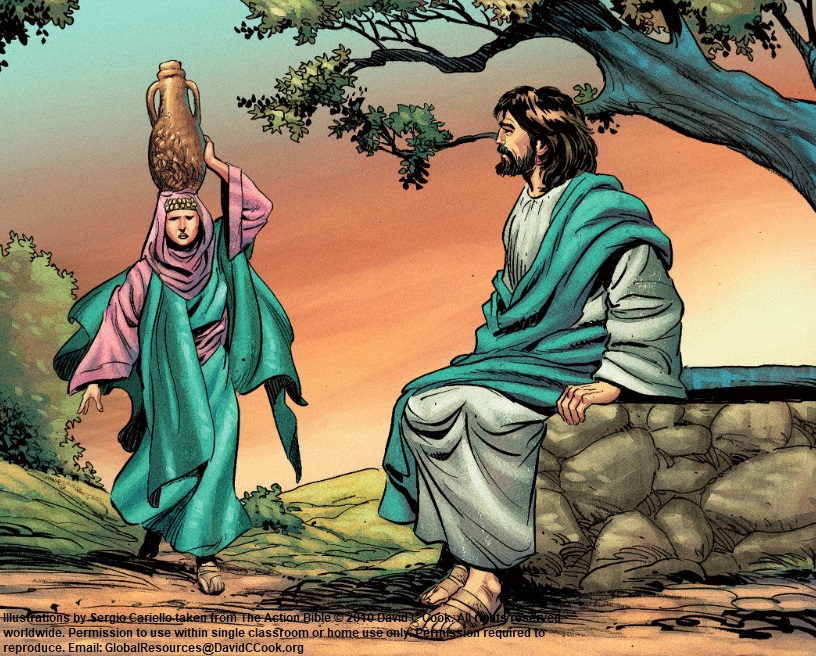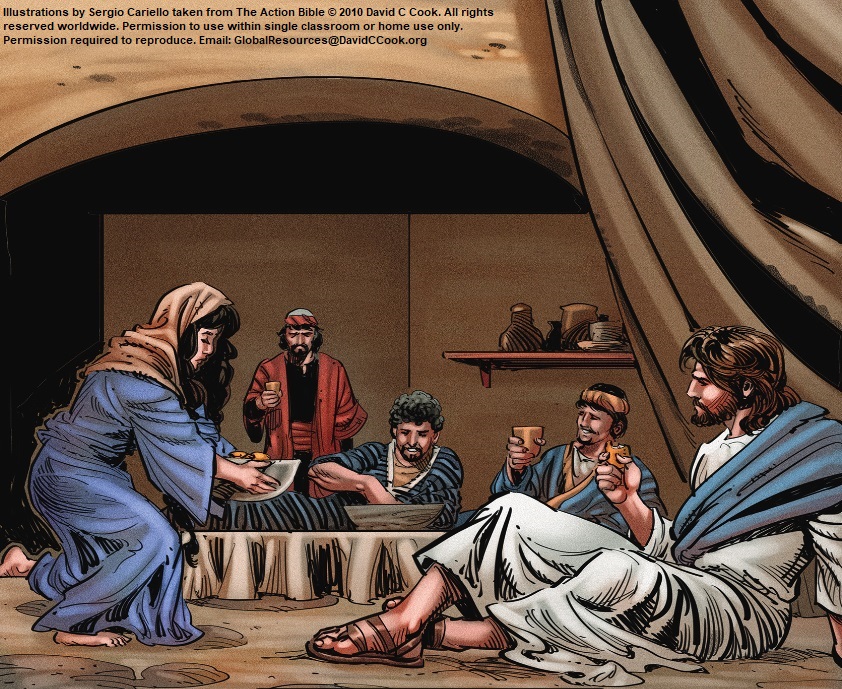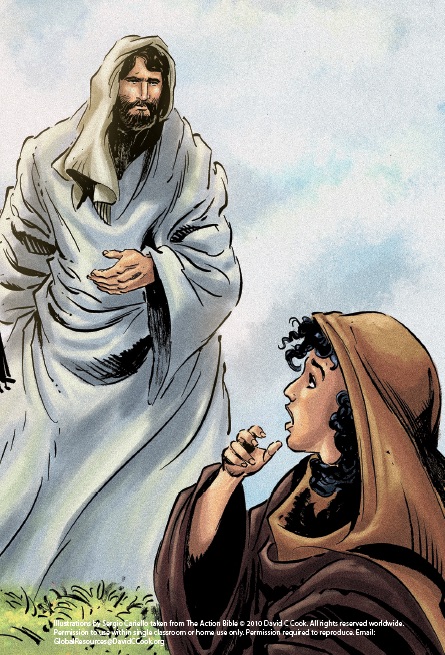During the lesson, the information for you to know is written in regular type, and what we suggest speaking or reading aloud to children is in bold. All resources for this lesson, including the Teacher Guide and Student Page, can be downloaded in a ZIP file by clicking on the following link:
In some lessons you will find "resource articles." These are articles written by experts from around the world to help equip you for your work with children and adolescents. Share them with parents or guardians if you consider it appropriate.
[Jesus] replied, “My mother and brothers are those who hear God’s word and put it into practice.”
Luke 8:21
Jesus does not discriminate. He does not care if you are a man or a woman. He does not care if you are young or old. He does not care if you are rich or poor. He does not care what language you speak or what colour your skin is. He wants you to draw near to Him so you can hear His Word and do it.
As you prepare to teach your students, read through the 3 stories in this lesson: Jesus and the Samaritan woman (John 4:7–26, 39–41), Mary and Jesus at Bethany (John 12:1–8), and Jesus and Mary Magdalene at the tomb (John 20:11–18). Just as Jesus knew and cared about these women, He knows and cares about you. How does He show His love and care to you? How have you seen Him work in you and through you? How has He changed you forever? Ask Him to help you to see His love and care for you, even in ordinary circumstances. And as you grow closer to Jesus, may you grow to love Him more and share His love and truth with others.
Encourage the students to think of 1 practical way to show honour for a female family member. Explain that their kindness may encourage others to treat women with more honour.
Teacher Tip: If possible, email or text the Family Connection Card to the families of your students.
As you welcome your students, ask them if they were able to show respect and honour to the girls and women they know. Invite 2–3 students to share their stories with the whole group.
Divide the teens into 3 groups. Give 1 Bible script page to each group. If possible, give each group a Bible. Have the students read the first paragraph on their pages before reading the Bible story. Then ask them to prepare skits for their stories. Encourage all students to participate, even though only some will have speaking parts. Others can be people in the community or objects such as trees or wells.
Give students 5–10 minutes to read their stories and prepare their skits. Copies of the stories are below for your reference. If possible, show the images from The Action Bible as you discuss each story.
Jesus and the Samaritan Woman
Jesus and His disciples were traveling through Samaria. Jesus sat down to rest near a well. In the time of Jesus, Jews and Samaritans had been bitter enemies for more than 500 years. Jesus was a Jew, and Jewish people did not speak to Samaritans. Also, men generally did not have conversations with women. But Jesus spoke with a Samaritan woman who was at the well alone, and He asked her for a drink of water. Read the story from the Bible in John 4:7–15, 25–26, 28–30. If you do not have a Bible, it is printed below.
When a Samaritan woman came to draw water, Jesus said to her, “Will you give me a drink?” (His disciples had gone into the town to buy food.) The Samaritan woman said to him, “You are a Jew and I am a Samaritan woman. How can you ask me for a drink?” (For Jews do not associate with Samaritans. Jesus answered her, “If you knew the gift of God and who it is that asks you for a drink, you would have asked him and he would have given you living water.” “Sir,” the woman said, “you have nothing to draw with and the well is deep. Where can you get this living water? Are you greater than our father Jacob, who gave us the well and drank from it himself, as did also his sons and his livestock?” Jesus answered, “Everyone who drinks this water will be thirsty again, but whoever drinks the water I give them will never thirst. Indeed, the water I give them will become in them a spring of water welling up to eternal life.” The woman said to him, “Sir, give me this water so that I won’t get thirsty and have to keep coming here to draw water.”
John 4:7–15
The woman said, “I know that Messiah” (called Christ) “is coming. When he comes, he will explain everything to us.” Then Jesus declared, “I, the one speaking to you—I am he.”
John 4:25–26
Then, leaving her water jar, the woman went back to the town and said to the people, “Come, see a man who told me everything I ever did. Could this be the Messiah?” They came out of the town and made their way toward him.
John 4: 28–30
If possible, show The Action Bible images as you tell the story.

Jesus and Mary at Bethany
Before the Jewish feast of Passover, Jesus stopped in the town of Bethany to visit Mary, Martha, and Lazarus. Jesus’ disciples were with Him, including Judas Iscariot, who would eventually betray Jesus. Read the story from the Bible in John 12:1–8. If you do not have a Bible, it is printed below.
Six days before the Passover, Jesus came to Bethany, where Lazarus lived, whom Jesus had raised from the dead. Here a dinner was given in Jesus’ honor. Martha served, while Lazarus was among those reclining at the table with him. Then Mary took about a pint of pure nard, an expensive perfume; she poured it on Jesus’ feet and wiped his feet with her hair. And the house was filled with the fragrance of the perfume. But one of his disciples, Judas Iscariot, who was later to betray him, objected, “Why wasn’t this perfume sold and the money given to the poor? It was worth a year’s wages.” He did not say this because he cared about the poor but because he was a thief; as keeper of the money bag, he used to help himself to what was put into it. “Leave her alone,” Jesus replied. “It was intended that she should save this perfume for the day of my burial. You will always have the poor among you, but you will not always have me.”
John 12:1–8

Jesus and Mary Magdalene at the Tomb
When Jesus died, His body was placed in a tomb. A few days later, Mary Magdalene, a follower of Jesus, went to check on His body. When she saw that the large stone in front of the tomb had been rolled away, she thought someone had stolen Jesus’ body. Mary ran to tell the disciples, and Peter and John returned to the empty tomb with her. When the men saw the tomb was empty, they went back home. But Mary stayed at the tomb and wept in sadness. Read the rest of the story from the Bible in John 20:11–18. If you do not have a Bible, it is printed below.
Now Mary stood outside the tomb crying. As she wept, she bent over to look into the tomb and saw two angels in white, seated where Jesus’ body had been, one at the head and the other at the foot. They asked her, “Woman, why are you crying?” “They have taken my Lord away,” she said, “and I don’t know where they have put him.” At this, she turned around and saw Jesus standing there, but she did not realize that it was Jesus. He asked her, “Woman, why are you crying? Who is it you are looking for?” Thinking he was the gardener, she said, “Sir, if you have carried him away, tell me where you have put him, and I will get him.” Jesus said to her, “Mary.” She turned toward him and cried out in Aramaic, “Rabboni!” (which means “Teacher”). Jesus said, “Do not hold on to me, for I have not yet ascended to the Father. Go instead to my brothers and tell them, ‘I am ascending to my Father and your Father, to my God and your God.’” Mary Magdalene went to the disciples with the news: “I have seen the Lord!”
John 20:11–18

After the students have prepared their skits, give each group a few minutes to present their skit. Have them read the paragraph at the top of their page aloud and then perform their skit. Encourage the teens to clap for each group. After the skits are finished, ask the students to sit down to talk about them.
They were encounters between Jesus and women. Jesus treated the women with honour. Jesus showed that He knew the women and loved them.
Students may answer that these stories are in the Bible because they show us how Jesus treated women. They are examples to us.
Each of the 3 Bible stories involved an encounter between Jesus and a woman. In these true stories, He showed His love and honour for them. We can learn a lot from the way Jesus treated women.
In the first story, Jesus showed respect by speaking to the woman at the well, even though she was both a woman and a Samaritan. In Jesus’ day, the Jewish and Samaritan people hated one another. Also, we know that the woman was alone at the well, which meant that she was not accepted even in her own society. In that culture, women would have gone to the well in groups. But this woman was alone because other women did not approve of her. And men, especially important teachers like Jesus, would not have spoken to a woman, especially one who was not accepted by society.
Another important thing about this story is that this is the first time Jesus revealed that He was the Messiah, the “anointed one,” the king the Jewish people had been waiting for. He told the woman that He offers eternal life to those who trust Him. Rather than sharing this important information first with His disciples or with religious leaders or government officials, Jesus chose to share it with an outcast Samaritan woman at a well. Because she believed in Jesus and shared this news with others, many more people in Samaria began to have faith in Him.
Jesus treated the women with kindness and honour.
He spoke to her even though others would not. He shared His love with her. He revealed Himself to be the Messiah for the first time.
Allow 2–3 students to share their thoughts.
In the second story, Jesus was having dinner with some close friends. Mary, one of His followers, sat at His feet. She poured expensive perfume on Jesus’ feet and wiped them with her hair.
Judas Iscariot, another follower of Jesus, complained about what Mary was doing. He said the expensive perfume should have been sold and the money used to help the poor. But Jesus defended Mary. He knew that her actions were motivated by her love for Him—a love so great that she was willing to ignore her culture’s restrictions on women. Rather than correcting her as Judas did, Jesus recognized her love and faith. He received the love and honour that she gave freely.
Jesus treated her with kindness and honour.
He did not rebuke her. He publicly recognized what she did for Him. He defended her against Judas.
Allow 2–3 students to share their thoughts.
In the final story, Mary Magdalene (a different Mary than in our previous story) went to the tomb of Jesus to weep for Him. When she saw Jesus, she did not recognize Him. But when Jesus said her name, she was overwhelmed with joy. Jesus had been resurrected from the dead. He is alive! And He called her by name! This showed Jesus’ great love for her.
Jesus chose Mary to be the first person to see Him after His resurrection. He did not choose an important government official or a man with power and influence. He did not even choose one of His male followers, even though some of His disciples had already visited the tomb. Instead, He gave Mary the honour of being the first to see Him and the first to share the news of His resurrection with the world. This was an unusual choice for that time. In Jesus’ time, the testimony of women would not usually have been valued.
Jesus treated her with love and honour.
He called her by her name. She was the first person He revealed Himself to after His resurrection. He asked her to share this news with His disciples.
Allow 2–3 students to share their thoughts. Be sure to bring up appropriate cultural stereotypes, practices, or restrictions that illustrate disrespect toward women or show that they are not valued as highly as men.
In the Bible, there were many women who followed Jesus and had faith in Him. He knew them personally and saw them as unique and special individuals. Jesus’ actions give us an example of how to treat others, including women and girls, with respect and honour. Jesus did not choose how He would respond to others based on the rules of the culture. Instead, His choices reflected the will of God. Because of this, He treated everyone He met as God does—with honour and love.
Have a student read Romans 12:10 aloud from the Bible.
Show the Memory Verse poster if you are using it.
Love each other with genuine affection, and take delight in honoring each other.
Romans 12:10, NLT

Turn to someone sitting near you. In your own words, explain to your partner what this verse means.
Give them time to discuss what they think the passage means. Then ask 2–3 students to share their thoughts with the whole group.
The Bible tells us to love each other with genuine affection and to take delight in honouring each other, and this applies to everyone. We are called to honour every person regardless of their language, social class, abilities, gender, or any other differences. God loves us all equally and completely—and He calls us to love each other in the same way.
Divide the students into groups of 3–4. Ask each group to come up with a situation where a person might be treated dishonourably. Ask them to consider how society would expect them to respond. Then ask them to consider how Jesus would respond. Invite 2–3 groups to share their situations and responses with the whole group.
Let’s think about the 3 Bible stories again: Jesus and the Samaritan woman, Jesus and Mary at Bethany, and Jesus and Mary at the tomb. These stories give us examples of how Jesus treated women with honour and love. They also give us examples of how we can respond to Jesus.
Optional: If you are using the Student Pages, there is space for the students to respond on the page.

Have the students spread out throughout your space. They still need to be able to see and hear you.
Just as Jesus loved these women, He loves you. Jesus loves you so much that He chose to die to pay the price for your sins. He wants to forgive your sins and live with you forever. Nothing you have ever done can separate you from His amazing love. He invites you to accept His gift of grace and choose to follow Him. It does not matter if you are a woman or man, girl or boy. Jesus loves you and wants to have a relationship with you!
Think about Jesus’ love for you. If you want to respond to His love by showing your love for Him, you can respond as the women in these Bible stories did.
Ask the students to close their eyes so they can respond individually.
The Samaritan woman at the well wanted to learn more about Jesus. She spent time with Him. She listened to what He had to say. She believed the truth He spoke to her.
If you want to learn more about Jesus, like the woman at the well, hold your hands near your ears. Let Jesus know that you are listening—that you want to know His truth. Let Him know that you want to be filled with the water that gives eternal life. You can ask Him to forgive you for your sins and accept His gift of forgiveness.
Give the students 1–2 minutes to respond silently.
When she poured perfume on His feet and wiped them with her hair, Mary was worshipping Jesus. She responded with love to the respect and love He showed her. She trusted Him and wanted to show Him how much she loved Him. She worshipped Him by washing His feet with precious perfume to show that she was giving Him something even more precious—her heart.
If you would like to do something beautiful for Jesus, hold your hands over your heart. Let Him know that you would like to give Him the things that are most precious to you because His love has far greater value. Let Him know that He lives in your heart. You can worship Jesus by telling Him in prayer how amazing He is or by quietly singing a song to Him.
If He does not yet live in your heart, you can invite Him in. You can accept the beautiful thing He has done for you—giving His life to pay the price for your sins. You can put your trust in Him and ask Him to be your Saviour.
Give the students 1–2 minutes to respond silently.
In the early morning, Mary Magdalene visited Jesus’ tomb. She came to mourn Him. When she found He was not there, she wept. But Jesus called her by name! Then she turned and saw His face! It was then she knew—He was alive! When she discovered this amazing news, she wanted to be with Him. He asked her to share the news of His resurrection with others, and she did.
If you want to respond to Jesus by sharing His love with others, hold your hands up above your head. Let Jesus know that you trust Him and believe in Him. Let Him know you want Him to call you by name. You can ask Him to help you see when and where He wants you to share the message of His grace and forgiveness. Ask Him to prepare your heart to share this important message. Ask Him for wisdom and courage to share about His love with others.
Give the students several minutes to respond individually to Jesus. Then close your time with a blessing over your students based on Romans 12:10:
Blessing: May the Jesus who loves you deeply and sees you as the most precious of all His creations help you to see others as He does. May His example of respect and love guide the way you treat others, and may you take delight in honouring others as He does.
Lead the teens in singing this quarter’s song, if possible.
Life on Life ©2020 David C Cook. Reproducible for home or classroom use only. All other uses require written permission from David C Cook [email protected]. All rights reserved.